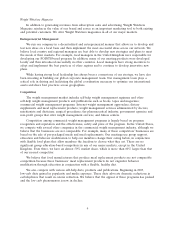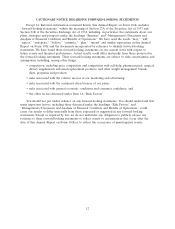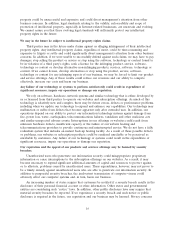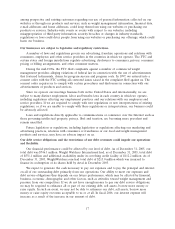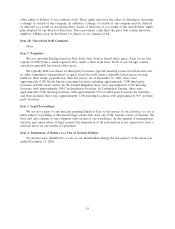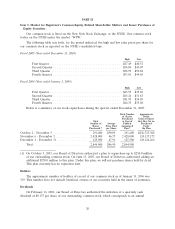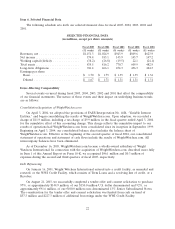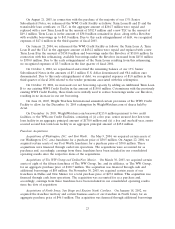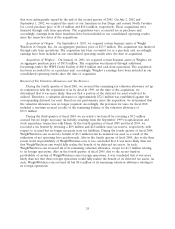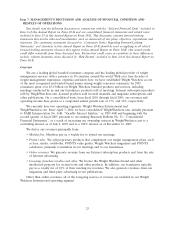WeightWatchers 2005 Annual Report Download - page 26
Download and view the complete annual report
Please find page 26 of the 2005 WeightWatchers annual report below. You can navigate through the pages in the report by either clicking on the pages listed below, or by using the keyword search tool below to find specific information within the annual report.property could be unsuccessful and expensive and could divert management’s attention from other
business concerns. In addition, legal standards relating to the validity, enforceability and scope of
protection of intellectual property, especially in Internet-related businesses, are uncertain and evolving.
We cannot assure you that these evolving legal standards will sufficiently protect our intellectual
property rights in the future.
We may in the future be subject to intellectual property rights claims.
Third parties may in the future make claims against us alleging infringement of their intellectual
property rights. Any intellectual property claims, regardless of merit, could be time-consuming and
expensive to litigate or settle and could significantly divert management’s attention from other business
concerns. In addition, if we were unable to successfully defend against such claims, we may have to pay
damages, stop selling the product or service or stop using the software, technology or content found to
be in violation of a third party’s rights, seek a license for the infringing product, service, software,
technology or content or develop alternative non-infringing products, services, software, technology or
content. If we cannot license, develop alternatives or stop using the product, service, software,
technology or content for any infringing aspects of our business, we may be forced to limit our product
and service offerings. Any of these results could reduce our revenues and our ability to compete
effectively, increase our costs and harm our business.
Any failure of our technology or systems to perform satisfactorily could result in expenditure of
significant resources, impair our operations or damage our reputation.
We rely on software, hardware, network systems and similar technology that is either developed by
us or licensed from third parties to operate our websites and subscription offerings. As much of this
technology is relatively new and complex, there may be future errors, defects or performance problems,
including when we update our technology to expand and enhance our capabilities. Our technology may
malfunction or suffer from defects that become apparent only after extended uses. In addition, our
operations depend on our ability to protect our information technology systems against damage from
fire, power loss, water, earthquakes, telecommunications failures, vandalism and other malicious acts
and similar unexpected adverse events. Interruptions in our offerings or websites could result from
unknown hardware defects, insufficient capacity or the failure of our website hosting and
telecommunications providers to provide continuous and uninterrupted service. We do not have a fully
redundant system that includes an instant back-up hosting facility. As a result of these possible defects
or problems, our websites or subscription products could be rendered unreliable or be perceived as
unreliable by customers. Any failure of our technology or systems could result in the expenditure of
significant resources, impair our operations or damage our reputation.
Our reputation and the appeal of our products and services offerings may be harmed by security
breaches.
Unauthorized users who penetrate our information security could misappropriate proprietary
information or cause interruptions to the subscription offerings on our websites. As a result, it may
become necessary to expend significant additional amounts of capital and resources to protect against,
or to alleviate, problems caused by unauthorized users. These expenditures, however, may not prove to
be a timely remedy against unauthorized users who are able to penetrate our information security. In
addition to purposeful security breaches, the inadvertent transmission of computer viruses could
adversely affect our computer systems and, in turn, harm our business.
An increasing number of states require that customers be notified if a security breach results in the
disclosure of their personal financial account or other information. Other states and governmental
entities are considering such ‘‘notice’’ laws. In addition, other public disclosure laws may require that
material security breaches be reported. If we experience a security breach and such notice or public
disclosure is required in the future, our reputation and our business may be harmed. Privacy concerns
16





